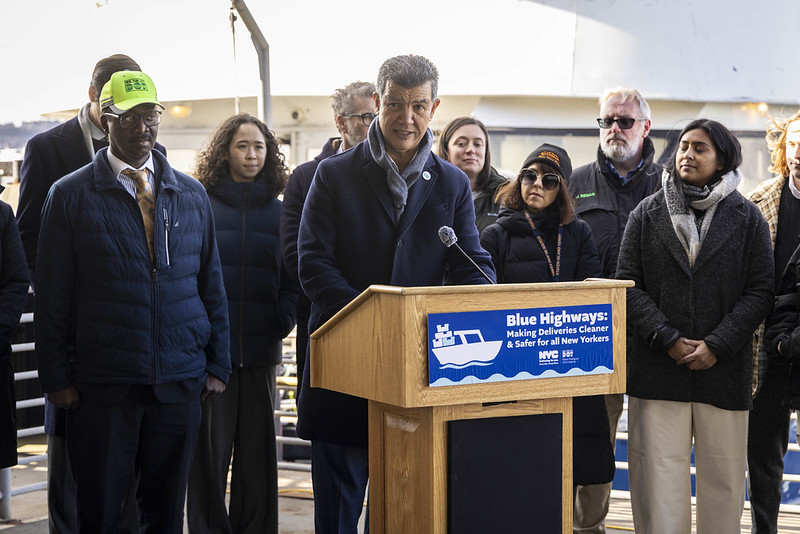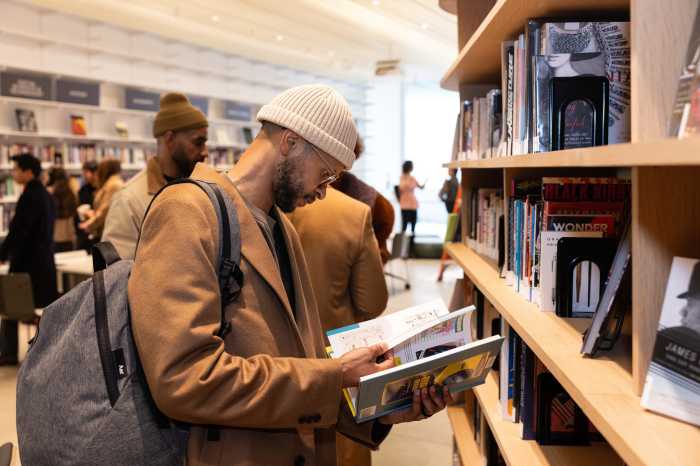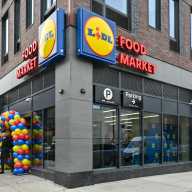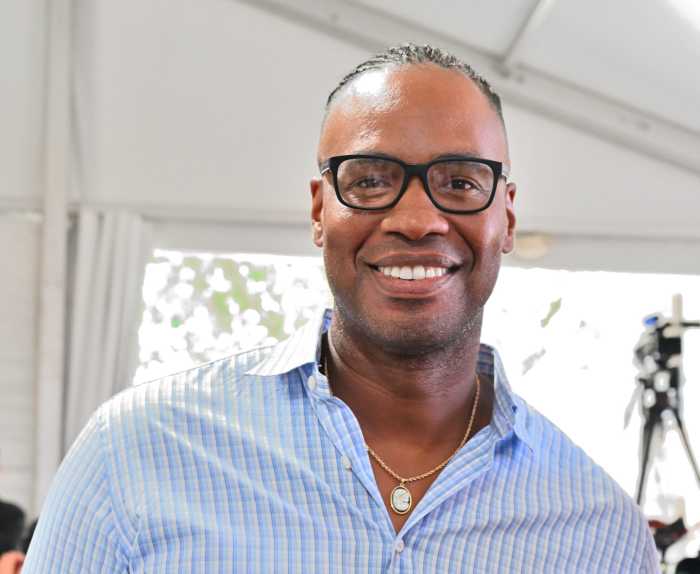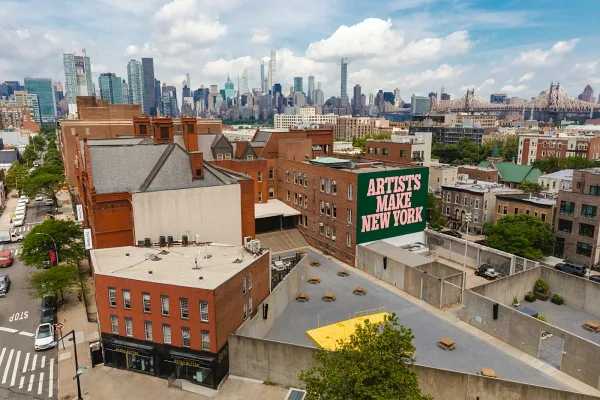19. Puppy love
Last year, this newspaper documented the thrilling hunt for Pickles, an Australian-cattle-dog mix recovered from Thai dog butchers and shipped to Brooklyn, who got hopelessly lost after running off during an August walk.
But the pup’s humans never gave up hope, and with help from a couple of professional pet trackers and animal lovers on social media, they finally found the wayward hound near Brooklyn College in November, three months after he disappeared.
Pickles wasn’t alone, however. His dad discovered the precocious pooch in the company of lady dog Violet, another escape artist that fled her foster family more than two years ago.
Pickles’ owners said they’re considering adopting Violet once they move into a larger apartment sometime this year, leaving local dog lovers with bated breath as they wait to see if the two furballs will spend the rest of their days together in the same forever home.
18. Going green
The last 12 months ended on a high note for Kings County tokers, after District Attorney Eric Gonzalez in 2018 expanded his predecessor’s non-prosecution policy for those caught smoking in public or with small amounts of weed, which led to a massive decline in marijuana-related arrests. And as Gonzalez’s leniency for smokers grew, so did that of Mayor DeBlasio, who last year instituted new policies to decriminalize pot puffing citywide.
Officials’ moves away from prosecuting many low-level weed offenses came as Brooklyn geared up to welcome its first medical-marijuana dispensary, whose owners will serve customers inside a swanky spa-like space on Flatbush Avenue across the street from the Barlcays Center.
Now, all red eyes are on Albany, where Gov. Cuomo — who adopted a more progressive stance toward recreational marijuana following his gubernatorial race against pro-legalization “Sex and the City” star Cynthia Nixon — is expected to announce the outcome of a state study into legislation that would regulate a so-called “Adult-Use Marijuana Program” early this year.
That’s right, stoners: 2019 may be the year that all your green dreams come true.
17. Fire’s afterburn
Southern Brooklyn’s premier mall, the Kings Plaza Shopping Center, literally fell into the red last September when an arsonist started a fire inside an outdoor garage there, injuring 26 people and destroying millions of dollars’ worth of cars in the process.
Cops cuffed the suspect soon after he allegedly torched the parking area, but the mall’s troubles persisted, with the Department of Buildings issuing its owners a violation for illegally storing vehicles for car dealerships in the garage.
And although the $620 fine will not likely sink the mall’s profits, the facility’s ongoing repair work — and the resulting congestion on nearby streets — are headaches for customers and local business owners, and show signs of continuing well into the year ahead.
16. Terms’ up
Community boards across the borough are set for dramatic shakeups, after New Yorkers last November voted via ballot referendum to enact term limits for members serving on the hyper-local groups.
The boards — whose members previously served two-year terms, and could seek additional terms indefinitely — must now limit members’ terms to four consecutive two-year stints. But members who want to dedicate more time to the panels are eligible to return, after a mandatory two-year break following their eight years of service in a row.
Proponents of the term limits argue they will help reshape Brooklyn’s 18 community boards to better reflect the fast-changing neighborhoods they represent. But opponents claim the new restrictions will force out many long-serving board members with important institutional knowledge gained from their decades of working with the community.
And as the civic panels begin a new year under their new regulations, just how the term limits will affect the boards — and the neighborhoods they serve — will start to materialize.
15. Dock decision
The fate of some notoriously controversial party boats remained adrift over the past year after the city promised to ship them out of their home port in Sheepshead Bay.
In April, local pols announced the boats would permanently sail away from their Emmons Avenue pier by September, but outraged Mill Basinites subsequently squashed a scheme to dock them in their neighborhood, and civic leaders on Community Board 18 in October strongly opposed a mayoral proposal to move the vessels to a pier at the Gateway National Recreation Area near Floyd Bennett Field — whose operators said they couldn’t accommodate the boats by spring 2019 even if they tried.
And with months to go before the cruising season kicks off again, the city is running out of time to find a new port for the party boats.
14. More ways to play
The People’s Playground will be more fun than ever in 2019 thanks to a host of new attractions funded by the city’s Economic Development Corporation and the Department of Parks and Recreation.
Last year, reps from the agencies requested proposals on how to develop a piece of Coney Island land the size of more than two-and-a-half football fields bounded by Surf Avenue, the Boardwalk, and W. 10th and W. 16th streets.
New Jersey-based amusement park developer-operator Central Amusement International ultimately won the job, and revealed plans to construct a log-flume water ride on an empty lot between the Thunderbolt roller coaster and MCU Park, and a zip-line adventure park on a stretch of what is now W. 15th Street between the coaster and the site of Luna Park’s former Coney Island Raceway.
The firm’s grand scheme also calls for constructing a pedestrian-only public plaza with an open-air food court and arcade games at the end of nearby Ruby Jacobs Walk. And if all goes according to plan, the zip-line attraction should open for thrill seekers this summer.
13. Ferry possible
After years of locals’ demands to bring the city’s ferry service to Canarsie, officials are poised to decide whether or not to create a stop at Canarsie Pier at the Jamaica Bay tip of Rockaway Parkway — which would bring a much-needed new way to commute to residents of the neighborhood with few other public-transportation options.
In August, Mayor DeBlasio committed to an end-of-2018 deadline to decide whether to include Canarsie in a forthcoming ferry-feasibility study conducted by the city’s Economic Development Corporation, which plans to explore several possible locations to bring the service — including places suggested by the public.
12. Changing Coney
Coney Island will likely look a lot different 12 months from now, thanks to a slew of construction projects that will bring bigger buildings containing hundreds of new apartments and retail and commercial space to the neighborhood.
Last month, local pols and leaders broke ground on the first part of a three-phase Surf Avenue development that spans the blocks between W. 16th and W. 20th streets, and will include nearly 1,000 affordable units and two-and-a-half football fields’ worth of retail space. Another so-called affordable-housing project, set to open early this year at W. 21st Street and Surf Avenue, will contain more than 130 below-market-rate apartments — more than 80 of which are earmarked for formerly homeless veterans — along with nearly two basketball courts’ worth of ground-floor retail space.
And a third development team is poised to begin renovations to the exterior of the landmarked Shore Theater once the city signs off on its plans that the local community board already approved, as part of the site’s transformation from a vacant former house of Vaudeville into a new hotel and spa.
11. Surpassing Chicago
Thanks to Midwestern migrants and some good-old-fashioned baby making, the borough is on track to overtake the Windy City as the United States’s third-most populous metropolis any year now.
In fact, 2017 population estimates from the federal Census Bureau show Brooklyn is home to 2,648,771 people, roughly 65,000 fewer than Chicago’s 2,716,450 — suggesting that Kings County may have already outpaced the Illinois city over the last 12 months.
But we likely won’t know if the number of people in our beloved borough outpaced that of Chicago until after the 2020 Census, and until then, Brooklynites intent on claiming the crown of third-largest American city should follow this newspaper’s strictly amoral guide to increasing the population.
10. Making the Census count
Speaking of the 2020 Census, a contingent of local experts, activists, and pols are already fast at work preparing for the next installment of the once-a-decade head count, which they claim could have an outsize negative effect on parts of Brooklyn if it includes a question about citizenship that the Trump administration wants to add.
This month, a federal judge will begin to hear arguments over the legality of that question, which local leaders fear could dissuade the many immigrants and people of color living in Brooklyn from participating in the census, resulting in cuts in federal funding and decreased political representation for parts of the borough.
And the fight to ensure a fair count isn’t only being waged in the courts — Borough President Adams last year launched his “Make Brooklyn Count” campaign led by a committee of local civic gurus and residents from traditionally undercounted communities, which is tasked with ensuring all eligible residents participate in the census.
9. Blue aftermath at home …
The first effects of the so-called blue wave that gave Democrats a tighter grip on swaths of Southern Brooklyn after the state midterm elections will start to materialize in January, when state Sen.-elect Andrew Gounardes (D–Bay Ridge) and Assemblywoman Mathylde Frontus (D–Coney Island) begin legislating in Albany.
Frontus clinched her seat by winning more than 53 percent of votes in a race against her GOP opponent, both of whom battled to fill the position vacated by convicted felon Pamela Harris, who resigned last year after the Feds charged her with stealing money from storm-recovery agencies.
And Gounardes won his seat by defeating long-time incumbent state Sen. Marty Golden (R–Bay Ridge) by a less than two-percent margin, earning just fewer than 50 percent of overall votes.
Gounardes, a Bay Ridgite who has never previously held elected office, is among a group of newly elected blue-party state pols that will give Democrats a true majority in New York’s state Senate — and control of Albany, with the governor and Assembly both blue, too.
8. … and ‘abroad’
Last November’s blue wave didn’t just shake up Albany — it also swept a Democrat into a Brooklyn Congressional seat held for years by Republicans, helping the blue party regain control of Congress’s lower chamber, and ending the GOP’s iron grip on all branches of the federal government.
Political novice and Congressman-elect Max Rose (D–Bay Ridge) won a contentious race against incumbent Rep. Dan Donovan (R–Bay Ridge), netting 52 percent of the votes in his district, which includes a swath of Southern Brooklyn and Staten Island.
Rose, like Gounardes, is part of a group of newly elected Dems that will put the party in control of the House of Representatives for the first time since 2010. That control already resulted in big changes for some other Brooklyn pols in the House, including Rep. Hakeem Jeffries (D–Canarsie), who in November assumed the powerful role of chairman of House Democratic Caucus.
And Jeffries’s colleague Rep. Jerrold Nadler (D–Red Hook), a vocal critic of President Trump, is poised to take over the House Judiciary Commitee — a panel that can initiate impeachment proceedings — when his party officially takes control of the chamber this month.
7. Another Bklyn pol for Advocate?
Kings County pols are practically falling over themselves as they jockey to get to the front of the pack of contenders hoping to replace former Fort Greene Councilwoman and outgoing Public Advocate Letitia “Tish” James, who heads to Albany this month to assume her new role as New York State Attorney General.
Councilman Jumaane Williams (D–Flatbush) last month won the endorsement of two self-proclaimed progressive Kings County Democratic clubs in his quest to win the watchdog seat, solidifying his place at the head of the pack after a candidates forum in Brooklyn Heights, where other local hopefuls including Councilman Rafael Espinal (D–Bushwick) and Assemblywoman Latrice Walker (D–Brownsville) also stumped.
The Brooklyn Dems are among more than a dozen hopefuls campaigning in the citywide non-partisan election, which will take place on Feb. 26, Mayor DeBlasio announced on Dec. 29. And with weeks to go, expect front-runners including Espinal and Williams — who narrowly lost a bid to unseat New York State Lieutenant Gov. Kathy Hochul in September’s Democratic primary elections — to amp up their appeals to voters.
6. Gonzalez on Gonzalez
Prosecutors are still investigating the hit-and-run motorist who fatally ran over a 4-year-old girl in Bushwick — in June.
Driver Jeanette Maria killed little Luz Gonzalez while leaving an illegal parking space outside a laundromat at the corner of Wyckoff Avenue and Hart Street, backing out, turning, and driving into the girl and her mother Reyna Candia.
But when police caught up to Maria, who is rumored to be related to one of New York’s Finest, about a block away from the scene, they let her go. And District Attorney Eric Gonzalez’s office has yet to announce findings or charges resulting from his probe, despite such evidence as video of the deadly hit-and-run, which show Maria’s car noticeably bounce up and down as she ran over Gonzalez and Candia, who sustained injuries, before driving away.
But last January, Gonzalez concluded a similar, months-long investigation when he announced he would not charge the garbage-truck driver who hit and killed a cyclist in Greenpoint months before in August — suggesting the next few weeks could bring a long-awaited end to the Gonzalez case.
5. Garden’s new neighbors
Council last month green-lit a rezoning that will allow developers to build two controversial 16-story towers blocks from the Brooklyn Botanic Garden, after Crown Heights Councilwoman Laurie Cumbo struck a deal with the builders that she claimed will nearly double the amount of below-market-rate housing included in the project.
Cumbo agreed to allow towers roughly nine stories higher than the area’s current zoning law allows in exchange for a deal that will bring some 258 so-called affordable units to the area as part of the scheme. But her yes vote that culminated the two towers’ public-review process came as the public review for another, much larger Botanic Garden–adjacent development is about to begin in her district.
Builder Continuum Company wants to erect a six-building complex with towers as high as 37 stories — featuring some 1,450 units, half of which will be market-rate — on Franklin Avenue between Sullivan and Montgomery streets, which Botanic Garden leaders already took a hard stance against due to its size.
That land is also currently zoned for towers no taller than seven stories, and Cumbo again will ultimately cast the key Council vote on a rezoning necessary to build the complex.
4. Growing Gowanus
Officials last June released a plan to rezone a chunk of Gowanus to make way for taller residential buildings in parts of the historically industrial neighborhood, where the Feds are approaching the third year of their ongoing cleanse of its namesake canal.
The proposal, which came two years after the mayor first pitched the rezoning scheme back in 2016, zeroes in on Fourth Avenue between Pacific and 15th streets, where it recommends any newly built residential buildings participate in the city’s Mandatory Inclusionary Housing program, which requires developers to set aside a portion of units at below-market-rate rents.
And in exchange, the city would upzone those blocks to make way for larger structures — which could climb as high as 17 stories in some parts, five more than what’s currently allowed under a 2003 rezoning of the area.
Some locals worried that building bigger residential developments in the neighborhood could mean the end of its days as a blue-collar industrial hub. But Gowanus Councilmen Stephen Levin and Brad Lander last summer assured concerned residents that the scheme is not set in stone.
The city plans to release a second draft of its Gowanus rezoning this winter following its first months of shopping it to locals, whose opinions are sure to only grow louder as the scheme comes into focus.
3. BQX’s ‘Prime’ opportunity
Mayor DeBlasio’s plan to build a $2.73-billion waterfront trolley connecting Brooklyn and Queens met some roadblocks in 2018.
In April, members of his own administration doubted their boss’s initial promise that tax revenue generated by new development along the streetcar’s route would pay for the infrastructure alone. And in August, DeBlasio himself said his pet BQX project would derail without $1 billion from President Trump — putting its fate in the hands of his frequent political rival, who some Brooklyn pols in Washington, DC, said would be unlikely to pitch in a penny for the trolley.
Around that time, the city also revealed the project’s cost shot up to its current figure from a previous $2.5-million price tag, and that its Brooklyn route would skip Dumbo and terminate in Red Hook instead of Sunset Park, after planners shortened the tracks from 14 to 11 miles.
But the November news that online-retail giant Amazon will open a second headquarters in Queens along the proposed BQX line breathed new life into the seemingly stalled streetcar scheme, with some local officials now calling on the trillion-dollar company to help foot the bill for the form of alternative transportation — which the city previously said it wants to begin a necessary public review process for in 2020.
2. Fixing the BQE
The city is currently weighing at least three options for fixing the Brooklyn-Queens Expressway’s crumbling triple cantilever, a job that could begin as soon as 2020.
Transit officials first revealed their two plans for the repairs in September. Their so-called “innovative approach” would rebuild the 70-year-old length of expressway in one shot, but require turning the Brooklyn Heights Promenade into a six-lane speedway for vehicles for no less than six years in order to wrap the job by 2026. And their so-called “traditional approach” would instead rebuild the three-tiered highway lane by lane, work that could last into 2029 and cause traffic jams that officials warned could stretch for up to 12 miles.
But in November, the city announced it would consider a third option, proposed by leaders of civic group the Brooklyn Heights Association, that would send traffic on a temporary highway created on the Furman Street border of Brooklyn Bridge Park, instead of along the Promenade.
As the time until the fix’s kick-off drops from years to months, all eyes are on the city to see whether it will heed the concerns of those locals and pols who demanded officials keep cars and trucks off the Promenade, or if Mayor DeBlasio will move forward with transforming the walkway into a speedway — an option he already came out in favor of, that he likened to pulling off a Band-Aid.
1. Welcome to L
The time is near, Brooklynites. After years of fretting over and planning for the so-called “L-pocalypse,” the 15-month suspension of Brooklyn–Manhattan L train service will commence on April 27.
Last month, Gov. Cuomo took a late-night tour of the subway’s East River–crossing Canarsie Tube with independent engineering experts, suggesting the pros might come up with a way to shave time and money off the repair plan members of the pol’s own administration put together to fix the infrastructure ravaged by superstorm Sandy.
But following his trek, Cuomo told a radio station that local commuters shouldn’t get their hopes up for the job to finish much earlier than its initial June 2020 deadline.
That means the roughly 250,000 straphangers who cross the river daily on the L should plan to avail themselves of officials’ many alternative-commuting options, which include beefed up service on the G, J, M, and Z trains; dedicated ferries between Williamsburg and Manhattan, with as many as three floating across the river per hour daily; new bike lanes along Grand Street; a high-occupancy vehicle lane across the Williamsburg Bridge during a daily “rush-hour” window; and five new bus routes.
Some of the alternative transportation options, including the new bus routes and dedicated ferry service, will launch on April 21, giving riders a few days to settle into their new commutes. But the rest will kick in on April 28 — the day after the L train starts its temporary stint as Brooklyn’s new local line running exclusively between Canarsie and Bedford Avenue.


















